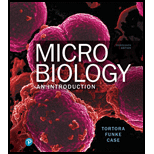
Concept explainers
Introduction:
The immune system is defined as the group of cells or tissues or organs that functions against the foreign substance to provide the immunity. The immunity is classified into two categories, innate and adaptive. The innate are non-specific defense mechanism, which acts immediately after the exposure of antigens or foreign substances on the body. The adaptive are antigen-specific immunity that adapts the immune system by formation of immune cells or memory cells for specific antigen.
Adaptive immunity acquires either be actively or passively, when person exposed to microorganism or foreign substances. The active and passive acquired immunity cab be obtained by natural or artificial ways. Based on this, the adaptive immunity is categorized into four types.
Want to see the full answer?
Check out a sample textbook solution
Chapter 17 Solutions
Microbiology: An Introduction (13th Edition)
- What is a PAMP an example of? Dendritic cell Complement Antibody Antigenarrow_forwardExplain the "antigen recognition by cells of adaptive immunity" in a simple way. Thank you, I will use this for infographics. NOTE: BULLET FORMarrow_forwardTrue/False: The C3 convertase of the alternative complement pathway amplifies the overall magnitude of complement activation regardless of which of the three pathways initiated the complement activation initially.arrow_forward
- Describe and give one example: artificial active acquired immunity artificial passive acquired immunity natural active acquired immunity natural passive acquired immunityarrow_forward*Passive immunity______. Group of answer choices requires exposure to an antigen may be obtained by taking antibiotics results in the production of memory cells is the result of vaccination All of these are correct *Which of the following is not a characteristic of immediate hypersensitivity? Group of answer choices excessive inflammatory response activation by harmless antigens activation of basophils secretion of lymphokinesarrow_forwardWhat immune defense would be most impacted for a patient with a C9 complement protein deficiency? Be specific.arrow_forward
- true or false the innate immunity system requires activation and must be specific to the invading pathogen.arrow_forwardwhy cannot freeze Human Normal Immunoglobulin injection?arrow_forwardWhich of these statements about complement proteins C3a and C5a is false?a. They are released during the complement fixation process.b. They stimulate chemotaxis of phagocytic cells.c. They promote the activity of phagocytic cells.d.They produce pores in the victim plasma membrane.arrow_forward
- Adaptive immunity can be divided into four distinct classifications, describe each: natural active immunity, natural passive immunity, artificial passive immunity, and artificial active immunity Describe the functions of each of the three classes of T cells.arrow_forwardWhich of the following are opsonins? Group of answer choices interleukins histamine oleic acid complements C3b and C4barrow_forwardContrast the pathways of complement activation.arrow_forward
 Human Anatomy & Physiology (11th Edition)BiologyISBN:9780134580999Author:Elaine N. Marieb, Katja N. HoehnPublisher:PEARSON
Human Anatomy & Physiology (11th Edition)BiologyISBN:9780134580999Author:Elaine N. Marieb, Katja N. HoehnPublisher:PEARSON Biology 2eBiologyISBN:9781947172517Author:Matthew Douglas, Jung Choi, Mary Ann ClarkPublisher:OpenStax
Biology 2eBiologyISBN:9781947172517Author:Matthew Douglas, Jung Choi, Mary Ann ClarkPublisher:OpenStax Anatomy & PhysiologyBiologyISBN:9781259398629Author:McKinley, Michael P., O'loughlin, Valerie Dean, Bidle, Theresa StouterPublisher:Mcgraw Hill Education,
Anatomy & PhysiologyBiologyISBN:9781259398629Author:McKinley, Michael P., O'loughlin, Valerie Dean, Bidle, Theresa StouterPublisher:Mcgraw Hill Education, Molecular Biology of the Cell (Sixth Edition)BiologyISBN:9780815344322Author:Bruce Alberts, Alexander D. Johnson, Julian Lewis, David Morgan, Martin Raff, Keith Roberts, Peter WalterPublisher:W. W. Norton & Company
Molecular Biology of the Cell (Sixth Edition)BiologyISBN:9780815344322Author:Bruce Alberts, Alexander D. Johnson, Julian Lewis, David Morgan, Martin Raff, Keith Roberts, Peter WalterPublisher:W. W. Norton & Company Laboratory Manual For Human Anatomy & PhysiologyBiologyISBN:9781260159363Author:Martin, Terry R., Prentice-craver, CynthiaPublisher:McGraw-Hill Publishing Co.
Laboratory Manual For Human Anatomy & PhysiologyBiologyISBN:9781260159363Author:Martin, Terry R., Prentice-craver, CynthiaPublisher:McGraw-Hill Publishing Co. Inquiry Into Life (16th Edition)BiologyISBN:9781260231700Author:Sylvia S. Mader, Michael WindelspechtPublisher:McGraw Hill Education
Inquiry Into Life (16th Edition)BiologyISBN:9781260231700Author:Sylvia S. Mader, Michael WindelspechtPublisher:McGraw Hill Education





